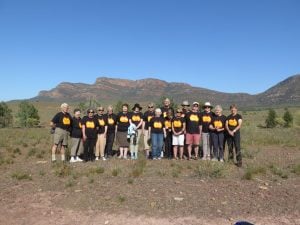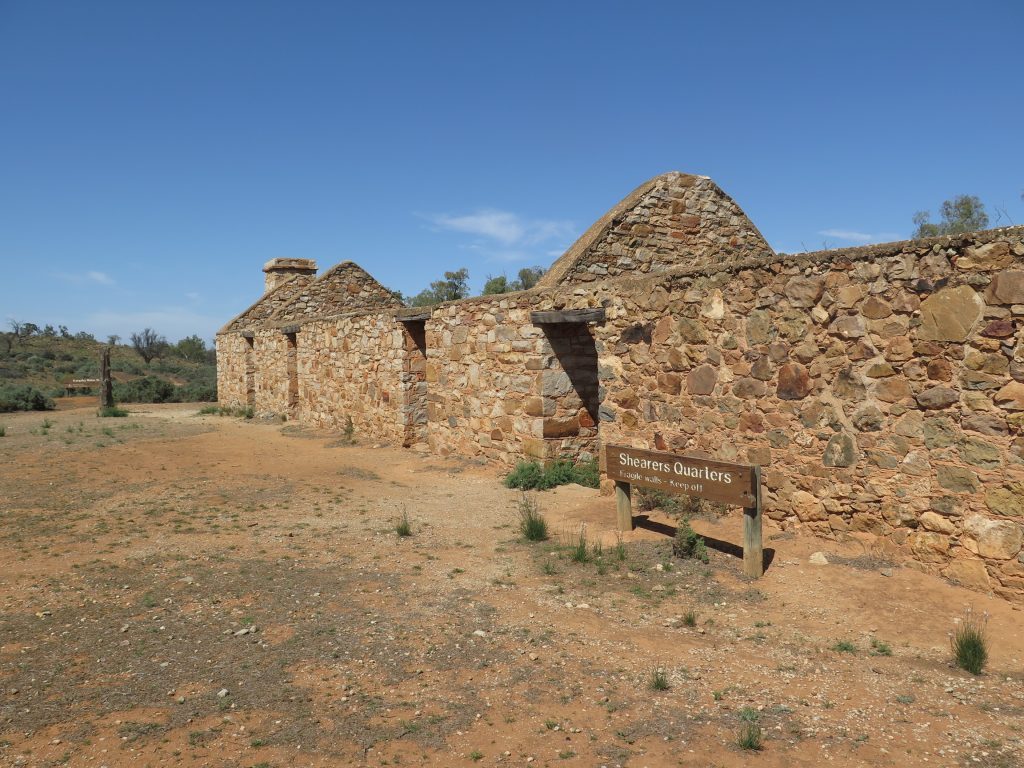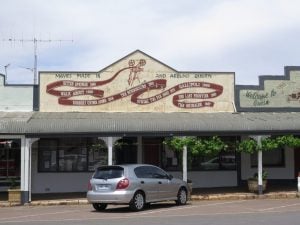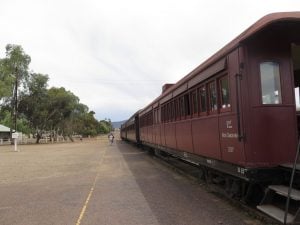CLICK ON IMAGES TO ENLARGE
28 October 2017
This morning we had the opportunity for a sleep in, our bags need to be at the vehicle by 8.45am. Again a nice hot breakfast in the dining room, and a last walk around the resort before we set off.
Our final destination today is Port Augusta, about 400 kms although the last 40 kms from Quorn will be on the old Ghan railway line through the historic Pichi Richi Pass.
As we were passing the end of the Rawnsley Range, Flick stopped the bus so we could take a group photo in front of this spectacular range to keep as a great memory of our time at Arkaroola Resort, then we drove on to revisit Hawker.
Most of us had missed a visit to the Hawker local store which contains a mind-blowing range of goods, and also a seismograph. The earth’s crust can be likened to a round ball with a soft centre and an outside shell cracked into many segments. These segments are continuously moving as they float on this soft centre.
Sometimes the edges of the segments rub against each other releasing a large amount of energy, this is felt as an earthquake. Seismology is the science of recording these movements.
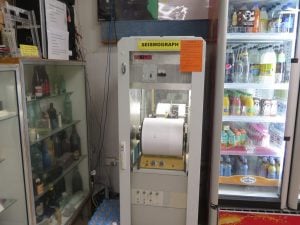 A sensor (called a seismometer), which is rather like a very sensitive microphone, is buried in the ground. The seismometer will detect any minor movements of the earth and produce a corresponding signal.
A sensor (called a seismometer), which is rather like a very sensitive microphone, is buried in the ground. The seismometer will detect any minor movements of the earth and produce a corresponding signal.
This signal is amplified many times and processed by electronic equipment. The signal may then be recorded by a pen on paper drum recorder or may be stored electronically (similar to a computer file).
The recording equipment is known as a seismograph.
This very sensitive equipment not only records earthquakes but also detects a number of other occurrences such as large animals moving about near the seismometer, heavy traffic on nearby roads or quarry and mining blasts. The resulting signal from each of these has a distinctive shape.
Then it was time to move on to the ruins of Kanyaka Station. Kanyaka station was one of the greatest pastoral runs of the southern Flinders, but only for a short time. It got off to a tragic start and its life was cut short by the expansion of wheat farming. Its ruined headquarters are clearly signposted on the western side of the road from Quorn to Hawker.
Hugh Proby, 3rd son of the Earl of Carysford, took up the Kanyaka and Coonatto leases for cattle in 1851. The next year, he was dead, drowned in the flooded Willochra Creek as he searched for cattle frightened by the same storm that sent the creek down in flood. Proby was only 24 when he died in 1852.
Proby was obviously loved by his brothers and sisters, because six years later, they arranged for a memorial stone to be set above their brother’s grave. And more than 40 years later one of his sisters, Lady Hamilton, came from England with her husband, Lord Hamilton, to visit his grave in the ranges beyond Quorn.
 Tragedy struck again when two young men, (James Grant and a Mr Roberts) rode north in the summer heat to take over the lease. But they strayed out of their way and died in the arid country to the north east. John Phillips, who inherited Kanyaka from Proby, settled there and managed the run. He built the massive station headquarters that soon came to look like a village.
Tragedy struck again when two young men, (James Grant and a Mr Roberts) rode north in the summer heat to take over the lease. But they strayed out of their way and died in the arid country to the north east. John Phillips, who inherited Kanyaka from Proby, settled there and managed the run. He built the massive station headquarters that soon came to look like a village.
The Phillips family entertained guests in the large dining room. It’s said that the family always ‘dressed’ for dinner. The polished wooden floor of the dining room was ideal for the dances that were held there. There was no doctor in the area, and one room was used by Mr Phillips as a surgery – for setting broken bones, extracting teeth, or treating any illness
The station office was also the post office. In 1862, over 23,300 letters were received at Kanyaka and nearly 21,600 were sent. The main dray route to the north passed by Kanyaka, and many called in at the homestead. Phillips got so sick of this that he built an eating house for travellers and teamsters, 5 km away from his home. By 1864 this had become a fine two storey hotel, the Great Northern. It had twenty four rooms, stables and a coaching house.
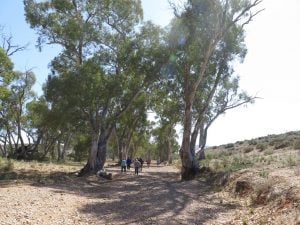 Both Coonatto and Kanyaka were hit hard by droughts in the 1860s. About 20,000 sheep died there. But they recovered in the good seasons and were doing well until these great pastoral leases were resumed for wheat farming in the mid 1870s. Kanyaka passed from Phillips to a company as a result of the 1860s drought.
Both Coonatto and Kanyaka were hit hard by droughts in the 1860s. About 20,000 sheep died there. But they recovered in the good seasons and were doing well until these great pastoral leases were resumed for wheat farming in the mid 1870s. Kanyaka passed from Phillips to a company as a result of the 1860s drought.
The hotel closed in 1881, soon after a new railway station 10km away at Wilson meant that carriers stopped there, not at Kanyaka. The hotel stood as a roofless ruin for decades, then its stones were crushed and spread as metal on the road that had passed it by. There is a little cemetery across the creek from Kanyaka. Most of the people there died before they were 50. One little boy, James Bole, was probably taken by dingoes. Kanyaka is a state heritage site.
Properties were heavily taxed for windows, floors and roofs, so when the houses were vacated all of these items were removed to avoid having to pay the taxes. Hence the state of the properties now, and unfortunately no one has come forward to restore these beautiful old buildings. The fact that many of them are still standing is testament to the skill of these early artisans.
Time then to move on to the quaint town of Quorn and our ride on the Pichi Richi Railway.
Nestled in a valley in the Flinders Ranges, Quorn was established as a town on the Great Northern Railway line in 1878. The line was built by Chinese and British workers and operated for over 45 years (it closed in 1957). Part of the line through Pichi Richi Pass has been restored as a tourist railway, taking passengers on a scenic 33-kilometre round trip via Port Augusta. The town’s old charm has not been lost on movie producers – the historic streetscapes and surrounding landscapes have been used in many films.
The railway from Port Augusta through the Pichi Richi Pass to Quorn opened in 1879, and was part of the first stage of the Great Northern Railway that was intended to link Port Augusta with Darwin. The Ghan name originated in Quorn in 1923 when the Great Northern Express was dubbed The Afghan Express by railwaymen. In 1929 this line reached Alice Springs.
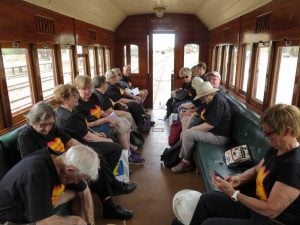 The East-West Transcontinental railway across the Nullarbor Plain was completed in 1917, and the Pichi Richi Railway became part of the East-West route for the next 20 years. Quorn was a vital railway junction, especially during World War II when military, coal and other traffic placed sizeable demands on the railway.
The East-West Transcontinental railway across the Nullarbor Plain was completed in 1917, and the Pichi Richi Railway became part of the East-West route for the next 20 years. Quorn was a vital railway junction, especially during World War II when military, coal and other traffic placed sizeable demands on the railway.
Washaways in the north and the incapacity of the railway to handle expanding traffic saw a new standard gauge railway constructed from Stirling North to Brachina, and the Pichi Richi Railway was closed to regular traffic in 1957.
Our destination for today is Port Augusta, located 68 kilometres northeast of Iron Knob and 300 kilometres north of Adelaide.
 In 1802, the English navigator Matthew Flinders first explored Spencer Gulf’s northern waters as far north as Redbanks – near present day Port Augusta. In common with other explorers of the time, Flinders explored the Port Augusta area hoping to penetrate the heart of the Australian continent. At the time such expeditions were mounted with the view of discovering a large navigable river or vast inland sea. Flinders was disappointed on both counts however. The legendary inland sea did in fact once exist, but basically Flinders was 120 million years too late. Having discovered no supplies of fresh water in the Port Augusta area Flinders then departed to complete his epic circumnavigation of the Australian continent.
In 1802, the English navigator Matthew Flinders first explored Spencer Gulf’s northern waters as far north as Redbanks – near present day Port Augusta. In common with other explorers of the time, Flinders explored the Port Augusta area hoping to penetrate the heart of the Australian continent. At the time such expeditions were mounted with the view of discovering a large navigable river or vast inland sea. Flinders was disappointed on both counts however. The legendary inland sea did in fact once exist, but basically Flinders was 120 million years too late. Having discovered no supplies of fresh water in the Port Augusta area Flinders then departed to complete his epic circumnavigation of the Australian continent.
By 1852 South Australian colonists had settled in Port Augusta and the town soon became a thriving commercial centre and port, serving the needs of pastoralists in the truly vast hinterlands to the north. For a time wool exports were the mainstay of Port Augusta’s economy with many London sailing clippers bearing cargoes to English wool mills.
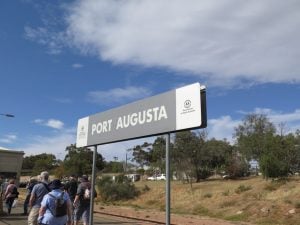 By the 1870s wheat had overtaken wool as Port Augusta’s chief export. Early promises of a thriving wheat industry proved illusory however. Rainfall was too unreliable and the area was subject to frequent droughts. The area soon resorted to its previous pastoral activities.
By the 1870s wheat had overtaken wool as Port Augusta’s chief export. Early promises of a thriving wheat industry proved illusory however. Rainfall was too unreliable and the area was subject to frequent droughts. The area soon resorted to its previous pastoral activities.
1877 saw the completion of the Overland Telegraph line that linked Australia’s eastern states to Perth. In the scheme of things Port Augusta played a crucial role as a major repeater station for the telegraphy network. With the completion of the Indian Pacific railway in 1917 Port Augusta began to assume the role of a pivotal transport hub.
Today Port Augusta’s unique geographic position sees it as a major service centre for travellers and freight trucks crossing the Nullarbor. In many respects Port Augusta is also the southern gateway to the Northern Territory. Travellers heading north can do so via the Stuart Highway. An alternate means of transport is to take a more leisurely journey via the “Ghan” rail service which was extended from Alice Springs to Darwin in 2003.
 During the construction phase of the newly completed Ghan Railway, Port Augusta played a major support role in the development of this landmark project. Just for the record, the Australian Government originally committed itself to completing the Adelaide to Darwin rail link in 1913. At Nullarbor Net we are not great supporters of the current Federal government, however we do congratulate Prime Minister John Howard and his cabinet for its commitment to constructing and completing this long awaited visionary project!
During the construction phase of the newly completed Ghan Railway, Port Augusta played a major support role in the development of this landmark project. Just for the record, the Australian Government originally committed itself to completing the Adelaide to Darwin rail link in 1913. At Nullarbor Net we are not great supporters of the current Federal government, however we do congratulate Prime Minister John Howard and his cabinet for its commitment to constructing and completing this long awaited visionary project!
Since February 2004 Great Southern Railways has been operating the regular Ghan service linking Adelaide through to Alice Springs, and beyond to Darwin. From the traveler’s viewpoint this railway project certainly was a long time coming, but it has been well worth the wait. The newly extended “Ghan” railway line has proven itself to be one of the world’s great train journeys. Great Southern Railways also operates the Indian Pacific train service which runs from Sydney and Adelaide, through to Port Augusta, and across the Nullarbor to the Western Australian Goldfields and Perth. The Indian Pacific train service runs several times a week and we reckon that’s definitely travelling the Nullarbor in fine style!
Tonight we enjoyed a delicious dinner in Port Augusta, this will be our last dinner for the tour, tomorrow we return to Adelaide via the Clare Valley.


